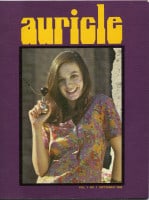The Auricle was a short-lived liberal arts journal that was published at the University of Saskatchewan between 1969 and 1971. Although it only lasted two years, The Auricle captured a moment at the U of S in a way that no history textbook ever could.
The Auricle was created as a follow-up to The Greystone — an annual yearbook that chronicled university and student life — after it was discontinued. The first issue was published in September 1969, possibly one of the most exciting and complicated times in history to be a university student. The school year began in the wake of Woodstock, the Manson family murders and the moon landing. The Vietnam War was underway and the threat of nuclear attack was constant. The world was changing, and students were changing with it.
At first glance, the inaugural issue doesn’t look like much. It’s a slim volume, made of heavy paper. A smiling girl with long, brown hair graces the cover. She’s as young and fresh as The Auricle itself was at the time. But then you open the cover and suddenly, you’re transported into the weird and wonderful world that was the U of S in the middle of the 20th century.
The magazine is equal parts bizarre and thought-provoking. The main feature is an in-depth interview with Humphrey Dumptruck, the namesake and lead banjoist for local Saskatoon band Humphrey and the Dumptrucks — who my mother, while attending the U of S in the early 70s, distinctly remembers going to see play at Sutherland Bar.
Writer and student Larry Gelman chatted with Dumptruck over food at Marquis Hall. The reader learns fascinating information about Dumptruck’s life, like how he “lives in sin with his Egyptian cat Smog” and that his most enjoyable high is a heavy dose of Coricidin D, a medication for pain and fevers, followed by several 222 tablets, commonly known as codeine.
Other issues of The Auricle contained short stories, poetry and photo spreads — notably one entitled “Bits and Pieces” which featured the body parts of a semi-nude woman, including her bare breast.
There was an article about the history of marijuana — “The Dope on Dope” — an illustrated preview of the new Place Riel Student Centre and quotes from Beatles songs.
The students who created this magazine went to the U of S almost 50 years ago. The world has changed a lot since September 1969 — and yet, it hasn’t.
University students still care about the same things. We go to see local bands play. We experiment with drugs and alcohol. We question what goes on in the world. We learn, we love and we still write.
These are the things that connect U of S students across history. The Auricle is a physical record of these connections. It reminds students that we’re not so different from our parents, our grandparents and even our professors. There is more that unites us than divides us.
Sadly, The Auricle only lived a short while before it was disbanded by a referendum put out by the SRC — the former U of S Students’ Union. They felt that the magazine lacked student interest and the energy of the previous yearbooks.
In perhaps a moment of ironic foreshadowing, the following quote was written in the introduction of the debut issue of The Auricle:
“The magazine format of the yearbook’s successor, Auricle, will allow involvement in current affairs; as an active and virile magazine should involve itself in the living and learning of the students: presenting before its readers information which they find interesting and relevant to the reality of the ‘space that they are in.’ The Greystone is dead, may it rest in peace; Auricle lives.”
While this passage may seem melancholy in hindsight, it isn’t wrong. The Auricle is not dead. It lives in the published words and images of students from a different generation, a generation faced with immense change. It lives in the U of S writers, thinkers, artists and dreamers that have come since.
The Auricle lives on, if only in our memories.